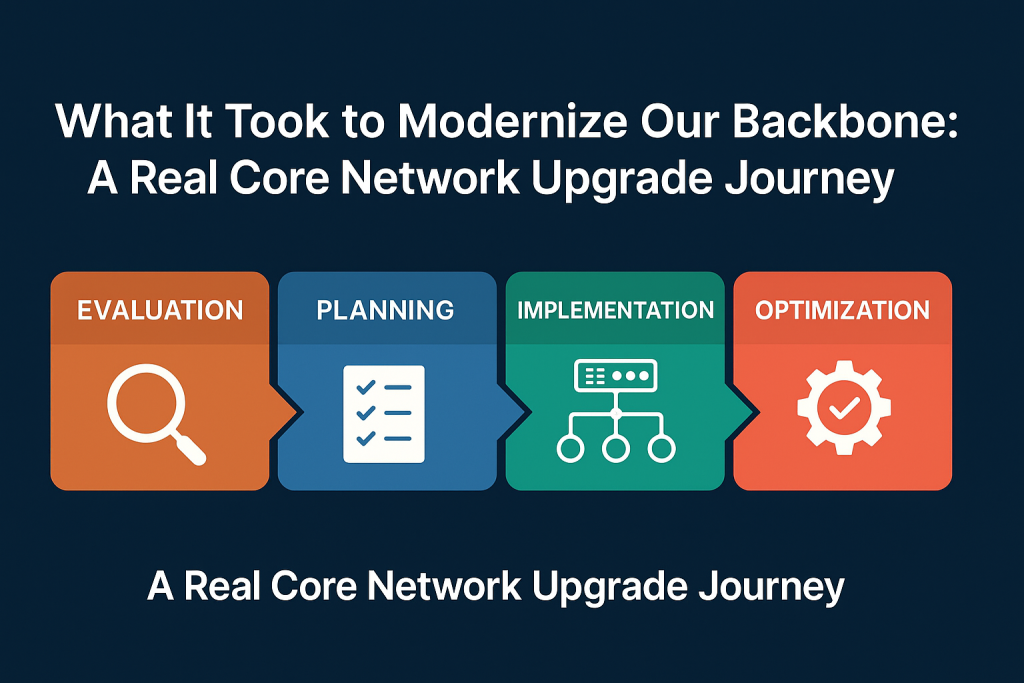
For nearly two decades, the hosting company we worked for carved its space in the market by being one of the first to offer Java hosting. A privately held, organically grown company that ran lean and smart, it thrived on optimizing operations while delivering reliable services to a global customer base.
My partner and I joined their small technical support team within six months of each other. Over the years, we grew into leadership roles — I focused on the business side, building processes, driving continuous improvement, and eventually becoming Managing Director. My partner, a technical mastermind, became the company’s CTO and infrastructure architect, leading innovation and resolving the most complex issues. Together, we formed a duo that pushed the company forward through several critical infrastructure projects, including:
But one challenge stood out as a turning point — a core network upgrade.
The Problem: Aging Cisco Routers Limiting Our Growth
The company’s core network stack was aging — built years before we joined, and never truly re-architected to meet modern demands. Our Cisco core routers had become a bottleneck:
- Gigabit limits while the industry had shifted to 10/25Gbps
- Random reboots taking the network offline for minutes
- High CPU and low memory during peak traffic
- End-of-life status, with no vendor support on the horizon
Customer expectations had changed. Infrastructure demands had grown. It was clear — if we didn’t act fast, we’d fall behind.
The Mission: Design a Future-Ready Core Network Upgrade
We kicked off an internal initiative to replace the legacy Cisco routers with a new core capable of:
- Handling high bandwidth and low latency
- Offering automatic failover and dynamic route discovery
- Enabling private inter-datacenter connectivity
- Integrating modern firewall and security features
- Supporting growth without disruption
After a thorough evaluation, we selected the FortiGate family by Fortinet — an enterprise-grade solution combining advanced routing, next-generation firewall (NGFW) capabilities, and built-in high availability. Its deep packet inspection, centralized management, and scalable design made it the right fit to support modern network demands, streamline security operations, and eliminate the need for multiple standalone devices. FortiGate enabled us to build a resilient, high-performance network core — ready for the future.
Routing, Redundancy & Private SD-WAN Setup
We weren’t just upgrading the routers — we were also redesigning our entire datacenter connectivity. Instead of using VPNs over the public internet, we set up:
- Private links between our datacenters
- A fully redundant SD-WAN setup using two separate providers
- BGP for automatic route discovery and failover between primary and secondary links
This allowed us to build a high-speed, private, and secure backbone that avoided unnecessary encryption overhead while maintaining privacy, stability, and resilience.
Execution: From Architecture to Cutover
Planning was everything.
This wasn’t just about swapping cables. It required:
- Redesigning network topology (separating public, internal, storage, and management networks)
- High availability and failover configuration
- Staged cutovers to reduce impact
- Deep coordination with our data center operations teams
We cut over segments of the network in phases, gradually migrating groups of systems until we executed the final cutover of our core link. And then, we repeated the process for the second data center.
Key Wins from the Core Network Upgrade
Despite the urgency and complexity, we delivered with minimal disruption. Here’s what we achieved:
- ✅ Eliminated service interruptions caused by failing Cisco gear
- ✅ Upgraded to 10Gbps uplinks from our data center providers
- ✅ Built redundant private SD-WAN links with seamless failover
- ✅ Implemented BGP-based routing and automatic discovery
- ✅ Improved internal network segregation and reliability
- ✅ Reduced ARP storms and stabilized performance
- ✅ Enhanced security posture with Fortigate’s firewall capabilities
- All of this — completed in just three months.
The Challenges We Overcame
We were racing against time — random reboots from the old Cisco gear were becoming more frequent. Beyond that:
- We had to maintain full uptime for customer workloads
- Troubleshoot unusual behaviors like excessive ARP flooding
- Coordinate multi-team cutovers with live rollback plans
- Deploy redundant SD-WANs and configure dynamic routing with BGP
- Transition to new segmentation models without breaking existing dependencies
But we made it — because the planning was intentional, the testing was thorough, and our teams were fully aligned.
What Came Next?
With the FortiGate routing backbone and private SD-WAN in place, we had the foundation to continue evolving. The next milestone? Replacing our aging switches across both datacenters — a project that came with its own set of challenges and wins.
But that’s a story for another time.
Core Network Upgrade Takeaways
- Proactive upgrades are essential — don’t wait for failure
- Proper planning and customer-centric execution can avoid disruption
- Redundant private interconnects provide stability without VPN load
- Aligning technical and business perspectives is key to success
🚀 Planning Your Own Core Network Upgrade?
Whether you’re struggling with legacy gear or planning for growth, we’re here to help.
🔧 See our Custom Projects & Migrations
👉 Let’s Talk About Your Network
